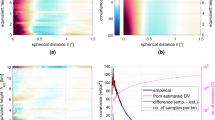Abstract.
It has long been known that a spherical harmonic analysis of gridded (and noisy) data on a sphere (with uniform error for a fixed latitude) gives rise to simple systems of equations. This idea has been generalized for the method of least-squares collocation, when using an isotropic covariance function or reproducing kernel. The data only need to be at the same altitude and of the same kind for each latitude. This permits, for example, the combination of gravity data at the surface of the Earth and data at satellite altitude, when the orbit is circular. Suppose that data are associated with the points of a grid with N values in latitude and M values in longitude. The latitudes do not need to be spaced uniformly. Also suppose that it is required to determine the spherical harmonic coefficients to a maximal degree and order K. Then the method will require that we solve K systems of equations each having a symmetric positive definite matrix of only N × N. Results of simulation studies using the method are described.
Similar content being viewed by others
Author information
Authors and Affiliations
Additional information
Received: 18 October 2001 / Accepted: 4 October 2002
Correspondence to: F. Sansò
Rights and permissions
About this article
Cite this article
Sansò, F., Tscherning, C. Fast spherical collocation: theory and examples. Journal of Geodesy 77, 101–112 (2003). https://doi.org/10.1007/s00190-002-0310-5
Issue Date:
DOI: https://doi.org/10.1007/s00190-002-0310-5




